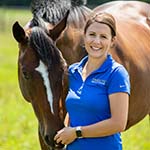While much of the attention on a breeding farm goes toward managing the nutrition of broodmares and young horses, it’s essential not to overlook a key player in the breeding program—the stallion.
Stallion nutrition follows the same fundamental principles as any other horse. Their diets should provide adequate non-energy nutrients, such as vitamins, minerals, and amino acids, along with meeting sufficient nutritional energy requirements to maintain a healthy body condition.
This article will explore the importance of nutrition during a stallion’s breeding season, how to nutritionally prepare stallions for peak reproductive performance, and the types of feeds and supplements that are best suited to support their needs.
Why Nutrition Matters When It Comes to Stallion Breeding
During the breeding season, a stallion’s nutritional needs typically increase and are generally comparable to those of a horse in light work. Providing a well-balanced diet is essential not only for the stallion’s overall health but also for optimal reproductive performance.
Breeding stallions require elevated levels of energy, high-quality protein, and key nutrients, including amino acids, vitamin E, and selenium, to support fertility and semen quality. A deficiency in protein, for example, can negatively impact both fertility and general health. If forage sources—such as hay—contain less than 8% crude protein, increasing access to high-quality pasture grass or adding a ration balancer to the horse's diet is a great way to help meet this nutrient need.
A stallion’s dietary requirements can vary significantly depending on factors like age, activity level, and health status. Equine nutritionists will take numerous considerations into account when designing a customized nutrition program for a stallion, including:
-
Breeding Status: Actively breeding stallions have higher nutritional requirements than those not currently in service.
-
Breeding Method: Live cover stallions typically expend more energy than those used solely for artificial insemination.
-
Activity Level & Exercise: Stallions that are high-strung, naturally active, or in training and competition have greater caloric needs to match their energy output and may require dietary adjustments to maintain optimal body condition.
How to Prepare for Stallion Breeding Nutritionally
As the breeding season approaches, it’s essential to fine-tune a stallion’s diet to ensure he receives the nutrients needed to support fertility, maintain ideal body condition, and meet the physical demands of increased activity.
Non-Energy Nutrients
Non-energy nutrients—such as vitamins, minerals, and amino acids—are essential not only for the overall health and well-being of stallions but also play a vital role in supporting fertility and semen quality. As the breeding season approaches, special attention should be given to ensuring these nutrients are provided at optimal levels.
Selenium, for example, is critical for maintaining the integrity of sperm cell membranes and supporting motility. Selenium deficiencies have been associated with reduced sperm motility and a higher incidence of structural abnormalities. Additionally, several nutrients serve as antioxidants, including selenium, as well as vitamin E, vitamin C, copper, and zinc.
While each key nutrient acts through different biological pathways, all help protect sperm cells from oxidative damage, which is now recognized as a major contributor to reduced fertility and poor post-thaw survival of frozen or chilled semen.
Key non-energy nutrients for breeding stallions include:
-
Selenium: Helps support sperm membrane integrity and motility.
-
Antioxidants (Vitamin E, Vitamin C): Help protect sperm from oxidative damage.
-
Vitamins A and D: A stallion’s requirement for these vitamins can increase by more than 50% during the breeding season.
-
Minerals (Calcium, Phosphorus, Magnesium): A stallion’s requirement increases during breeding activity and must be supplied in sufficient amounts to support overall health and reproductive function.
For easy keeper stallions or to add additional levels of these nutrients, a ration balancer is an ideal solution. Ration balancers provide essential vitamins and minerals without excess calories, helping to maintain fertility while preventing unwanted weight gain.
While providing a properly balanced, fortified horse feed is essential during the breeding season, it also remains necessary throughout the year. Using a well-formulated product at the recommended feeding rate ensures stallions consistently receive key nutrients without the need for multiple supplements year-round.
Omega-3 Fatty Acids
Omega-3 fatty acids, particularly DHA, are essential components of semen that play a critical role in supporting sperm motility, maintaining sperm cell membrane integrity, and enhancing overall semen quality.
Because omega-3s are incorporated into the sperm plasma membrane, dietary supplementation can improve reproductive parameters, including resistance to damage from cooling and freezing, which is especially important for stallions whose semen does not hold up well under these conditions.
Beyond improving semen quality and potentially increasing fertility rates, omega-3s also contribute to joint comfort and help reduce inflammation. These benefits are valuable during the increased physical activity of the breeding season. Research indicates that omega-3 supplementation is most effective when initiated at least 60 days before breeding, with algae-derived DHA serving as an ideal non-fish source option.
For optimal results and appropriate dosing, it’s recommended to consult with an equine nutritionist to tailor supplementation to your stallion’s specific needs. Products like Tribute’s Natural Remedy® are designed to deliver these benefits effectively.
Body Condition Score
Maintaining healthy body weight is critical for reproductive success, as underweight stallions may experience decreased fertility.
The ideal body condition score (BCS) for breeding stallions is between 5 and 6. Stallions should enter the breeding season within this range, with their energy intake adjusted as needed to maintain optimal body condition.
During the breeding season, a stallion’s activity level often increases while his attention span for feed may decrease. As a result, he may require more calories provided in smaller, highly palatable meals—such as high-fat, low-NSC full-intake feeds—to help stimulate appetite and ensure adequate nutrition intake.
Adding a well-formulated fat supplement to a balanced diet can also boost calorie density without significantly increasing feed volume. Additionally, turnout in a small paddock with access to grass can stimulate appetite and help maintain body condition.
Although stallions generally require about 20% more energy during the breeding season compared to non-breeding periods, it’s essential to avoid excess weight. Obesity in stallions has been linked to reduced libido and an increased risk of insulin resistance, so maintaining an ideal body condition is crucial for supporting reproductive performance. While research in horses is limited, human studies suggest that both excessive and insufficient body condition can negatively affect fertility.
Support Stallion Breeding Season with Tribute® Equine Nutrition
Tribute® offers a comprehensive range of feeds and supplements to support breeding stallions throughout the reproductive season.
These products are formulated to deliver energy and non-energy nutrients, along with ingredients that contribute to optimal stallion fertility, body condition, and reproductive health.
Essential K® and Wholesome Blends® Ration Balancers
For stallions that are easy keepers or not in heavy work, Essential K® and Wholesome Blends® Balancer provide concentrated levels of vitamins, trace minerals, and amino acids without adding unnecessary calories.
These balancers are rich in selenium and vitamin E, two critical antioxidants that support sperm motility and protect against oxidative stress. They also help meet increased nutritional demands during the breeding season without contributing to excess weight gain.
Senior Sport® and Synergize®
For stallions requiring more calories to maintain condition—especially those in live cover breeding programs or still in training—Senior Sport® and Synergize® are excellent choices.
These high-fat, lower NSC feeds provide energy-dense calories in smaller meals, making them ideal for stallions with increased activity during the breeding season. The lower NSC design also helps maintain metabolic stability, making it suitable for horses with metabolic conditions, and supports an overall healthy body condition.
Natural Remedy®
Natural Remedy® is Tribute’s omega-3 fatty acid supplement that also delivers algae-sourced DHA—a critical component of sperm cell membranes that enhances motility and improves semen quality.
Supplementation with DHA has been shown to improve resistance to cold shock during semen cooling and freezing, which is particularly important for stallions used in artificial insemination programs. Omega-3s also support joint comfort and help reduce inflammation, making this supplement a valuable addition during periods of heightened physical activity. For optimal results, start supplementation at least 60 days before the breeding season.
Wholesome Blends® Omega Plus Top Dress
Another beneficial option is Tribute’s Omega Plus Top Dress, a rich source of omega-3 fatty acids that helps support reproductive health, skin and coat condition, and anti-inflammatory balance.
While not as rich in DHA as algae-based options, flax and hemp-derived omega-3s still contribute to overall semen quality and fertility when used in combination with a balanced feeding program.
To ensure your stallion’s diet is nutritionally optimized for his individual needs, Tribute® Equine Nutrition offers free personalized feeding plans tailored to your goals and your horse’s unique requirements.
References
https://tributeequinenutrition.com/blogs/news/everything-you-should-know-about-vitamin-e
https://pubmed.ncbi.nlm.nih.gov/20450841/
https://tributeequinenutrition.com/blogs/news/omega-3-6-fatty-acids-in-horse-feeds
https://www.sciencedirect.com/science/article/pii/S0015028208033529


